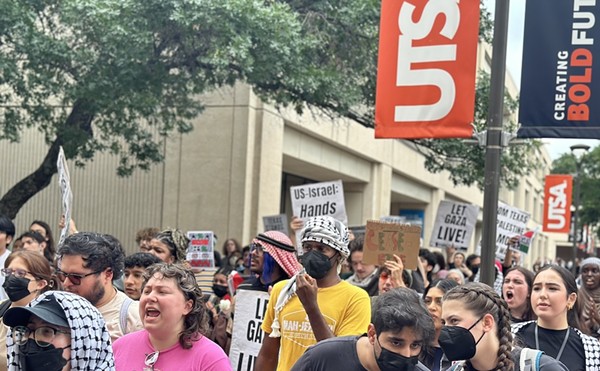A giant Gulf
If you served during the Gulf War and your claim for Post Traumatic Stress Disorder was denied, help may be on the way. Especially if your name isn’t Maria. Late last month, Secretary of Veterans Affairs Eric K. Shinseki announced the near completion of a study that might reopen thousands of Gulf War vet disability claims.
“This new approach is the first step in a still unfolding comprehensive plan of how VA will treat and compensate veterans of the Gulf War era,” Shinseki promised in a statement.
“Reaching out to Gulf War veterans is not only essential to our transformation of the VA, for many of us it is also personal,” said VA Chief of Staff John R. Gingrich, the chairman of the task force in charge of the study. “Having commanded troops in the Gulf War, and then witnessing some of them fall to mysterious illnesses has been very difficult to watch.”
Out of the 700,000 soldiers deployed as part of Operation Desert Storm in 1990 and ’91, about 300,000 have submitted disability claims, and 85 percent received benefits for “at least” one condition, says the report. Fourteen percent were denied any benefits, mainly because doctors couldn’t explain symptoms like chronic fatigue, skeletal pain, and skin rashes.
The task force recommends alerting veterans to potential exposure to dangerous chemicals, monitoring their long-term health, and improving the delivery of benefits, among other steps. But many vets aren’t popping the champagne corks just yet.
“We’ve heard all of this before,” Larry Clark, founder and editor of VAWatch.org, told the QueQue. “There are Vietnam veterans with Agent Orange `exposure` and for many years they’ve been hearing, ‘We’ll take care of you, we’ll take care of you.’ So now the government comes out with a new set of promises. What does it really mean?”
Upon closer examination, there is a subset of vets that should be even more skeptical: Women.
According to a Fall 2009 article in the William and Mary Journal of Women and the Law, the hurdles are even higher for soldiers of the fairer sex. “Female veterans have a higher burden of proof than male veterans when claiming PTSD disability benefits,” writes author Jennifer C. Schingle, associate counsel at the Board of Veterans’ Appeals and women’s law and public-policy fellow at Georgetown University.
Since women, in theory, are not allowed to engage in direct combat, Schingle reports that female soldiers who find themselves engaged in combat often lack sufficient documentation of exposure. And while most female claims for PTSD actually stem from Military Sexual Trauma — sexual assault — rather than battle, victims run into the same obstacle. In addition to the VA’s own data, the article cites figures by the National Center for PTSD that indicate “women are more likely than men to experience PTSD due, in part, to the fact that women are more likely to experience sexual assault.” Yet VA regulations require a victim of MST to provide corroborating evidence of an attack, while a combat veteran claiming PTSD benefits need only show evidence of combat.
The discrepancy doesn’t affect women alone.
“Research indicates that men have about a 65 percent chance of developing PTSD after a sexual assault, whereas they only have about a 39 percent chance of developing PTSD after combat exposure,” Schingle reports. “Therefore, the proposed changes in the VA regulations `should` help male MST victims as well as female victims.”
The article was originally assigned to Schingle by the Veteran’s Law Journal, which rejected the final version.
“During this process, I touched base with the editor-in-chief and told him that this could be sort of like a conflict-of-interest piece, because the Journal has a reputation of being very pro VA, and this was not going to be a pro VA piece,” Schingle told the QueQue. “He told me not to worry about it, but sure enough, I was told by the editor that the piece was not ready for publication, and they didn’t understand it.”
Schingle worries that she may be experiencing some career fallout.
“Suddenly, within the last month or so, my performance as an attorney has been questioned by my direct supervisors, but not really by anyone associated with the Journal,” she said. “It might be because I was critical of the VA, but I have no proof of that. We get performance evaluations on the decisions we write, and I’ve had no problems with my decisions until suddenly in the last few months.”
Hunger strike rights
On February 25, about three dozen vociferous activists gathered in front of the U.S. Immigration and Customs Enforcement building on Fourwinds Drive to call attention to alleged human-rights abuses at the Willacy County (“Tent City”) and Port Isabel detention centers, including forced feeding of immigrant detainees who are on hunger strike to protest conditions at the prisons.
“This is the pain,” said Southwest Workers Union’s Anayanse Garza, holding up a petition. “These are the 243 signatures of the people at Port IsabeI that have been tortured, beaten, and humiliated, and these orders were coming from `ICE’s field office director` Michael J. Pitts, who is sitting very comfortably in his air-conditioned room, while other people are being tortured and threatened with force-feeding by having a tube inserted through their noses.”
The QueQue counted 235 signers, each with a corresponding legal-resident number. The activists tried to present the petition to Pitts, but couldn’t get past security.
“They told us to mail it,” Grassroots Leadership’s Bob Libal told the QueQue.
According to the ICE website, Tent City and Port Isabel are detention centers for “individuals who are waiting for their immigration status to be determined or who are awaiting repatriation” — sometimes for years. Caught between the criminal-justice system and an increasingly criminalized civil immigration law, they have few rights. `See Reasonable Doubt, February 17, 2010.`
“Of the approximately 40,000 people in immigration detention, more than half have not been convicted of any crimes,” wrote attorney Aaron Haas in the Current in August 2009. Yet they are held in conditions most of us would not distinguish from a prison. After a rare field visit in June 2009, Amnesty International’s campaign director for refugee and migrant rights told the Houston Press that AI’s preliminary findings confirmed that detainees are “locked up, and you have no right to a bond hearing. You have no right to ever demonstrate that ... ‘I’m not a danger to the community, I’m not a flight risk, so let me out while I proceed `with` my removal proceedings.’”
One of the detainees AI spoke to during the Port Isabel visit was Rama Carty, a native of Congo who has resided legally in the U.S. since 1971. He was detained in Maine in May 2006 for a drug offense he claims was fabricated. After serving less than two years, he was held at ICE detention centers in Main, Massachusetts, New Hampshire, Pennsylvania, and Louisiana, before arriving at PIDC in December 2008. With two other detainees, he organized a hunger strike at PIDC on April 15, 2009, to expose the conditions at Port Isabel.
“We got at least 70 other detainees, maybe 90, but it went down quickly after the authorities started applying pressure on us,” he told the QueQue. “Some people did three weeks `of hunger strike`, but they threatened me with cutting me the access to the law library. I needed that, so I stopped.”
On June 3, the day he said he was supposed to meet with Amnesty for the second time, he was awakened at 5 a.m. by guards who told him to pack because he was leaving.
“I told them I shouldn’t be leaving, since `the Department of Homeland Security` was negotiating with AI to meet with us and I wasn’t done with my interviews,” Carty said. “I smelled something fishy immediately.”
That’s when he was attacked, he says, but the guards accused him of assault. On that same day, Carty was transferred to an ICE detention center in Louisiana, but couldn’t be deported because no country would recognize him as a citizen.
“I was going to be in limbo until who knows when,” Carty said.
In the fall of 2009, Carty successfully sued ICE and obtained a $100,000 unsecured bond that allowed him to walk free in December. After spending time in Massachusetts, he’s been back in Texas since February 22, under house arrest at a hotel in Brownsville, awaiting his March trial for the assault.
Carty won’t go on the record with details of the attack, but wants to set the record straight.
“I don’t want to publish specifics that will need to be divulged at trial,” he said. “But I do want to let everyone know that I was assaulted, not the other way around. When I could not be deported, I was wrongfully indicted in order to leverage against a possible civil action.”
Carty claims he was shaving when the guards jumped on him, but they’re saying that he used a razor to attack them.
“The missing video and the missing razor are two of the most glaring pieces of missing evidence,” Carty said. “It’s clear in the very little bit of video that the government has produced, which shows my being hit when I was on the floor at the very end of the incident, that the entire video should have been available. The entire video would have made it clear that I should not have been indicted in the first place. But of course there is no video, because if there is a video, they have no case.
“Everything happens at `PIDC`: Everything from sexual harassment of male and female detainees, assault, pitting black detainees against Hispanics and vice versa, in an attempt to divide and conquer. It’s a terrible situation and it has been going on for decades.”
“In all my years, I’ve never seen immigrants raising a hand against guards,” said Tony Hefner, a guard at PIDC from 1983 through 1990. “It’s always been the other way around.”
Hefner, who says he was fired in 1985 for reporting problems to the FBI, rehired in 1987, and fired again in 1990, again for reporting problems, spent years gathering information about abuses at PIDC. He’ll publish his findings, “real names and all,” in Between the Fences: Before Guantanamo, there was the Port Isabel Service Process Center, due out in May.
“The very same thing that happened `in my time` is happening today `at PIDC`,” said Hefner. “Stealing money from detainees, beating detainees up ... If detainees from two different countries were fighting, they would handcuff them together and push them into each other and take bets on them.”
Hefner will be a witness for Carty during the trial.
“They’re framing this young man claiming that he did something that he didn’t do,” Hefner said. “That’s the standard policy there: If you stand up against them, they nail you. What Rama `Carty` is going through is nothing unusual.”
Nina Pruneda, spokeswoman for ICE in San Antonio, said the QueQue’s info “is not correct information.”
“Torture? That’s the first time I ever heard of that,” she said Friday. “There are a lot of rumors in the community but, believe you me, there’s nothing of that nature going on.
“We need the names of those detainees. For security purposes we don’t obtain information like that `letting the activists into the building`; they have to mail it. That’s the process.”
So if you get the names ...
“Names, dates of birth, and `resident` numbers,” she said. “And Monday we’ll get back to you with the other information you requested.”•
















